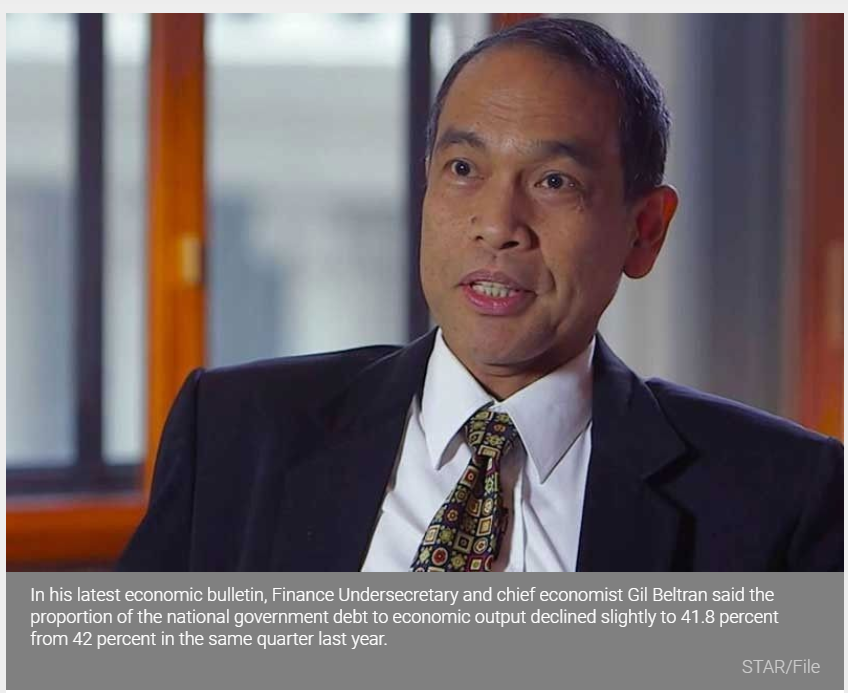Philippines: Debt-to-GDP ratio eases to 41.8% in 1st quarter
MANILA, Philippines — The share of the country’s debt to its gross domestic product (GDP) slightly eased to 41.8 percent in the first quarter, but may increase by the end of the year as the government continues its fight against the coronavirus disease 2019 or COVID-19 pandemic.
In his latest economic bulletin, Finance Undersecretary and chief economist Gil Beltran said the proportion of the national government debt to economic output declined slightly to 41.8 percent from 42 percent in the same quarter last year.
As expected, Beltran said the debt-to-GDP ratio stayed on a downward path as what was previously programmed before the coronavirus disease 2019 or COVID-19 outbreak happened.
“In the original program pre-COVID-19, debt ratio should decline and that was still the trend in the first quarter,” Beltran said in a text message.
However, Beltran said the country’s debt-to-GDP ratio is expected to increase to 49.2 percent by the end of the year as the government continues to tap multilateral agencies and bilateral partners, as well as the debt market, to help finance COVID-19 response efforts.
This is higher than the 39.6 percent debt-to-GDP level recorded by the end of 2019, which was an all-time low.
Debt-to-GDP ratio is an indicator used by debt watchers and credit rating agencies to assess a country’s debt sustainability. A lower ratio indicates the government is generating more resources than debts, giving it more payment capacity.
Based on data from the Bureau of the Treasury (BTr), the national government’s outstanding debt as of March 2020 reached an all-time high of P8.18 trillion, up by 4.8 percent from P7.8 trillion as of end-March last year.
The figure was also 5.8 percent higher than the P7.73 trillion recorded in end-2019 and 0.1 percent up from February’s level of P8.16 trillion.
Meanwhile, the Philippine economy contracted by 0.2 percent in the first quarter.
According to Beltran, prudent debt management has “enabled the government to mobilize substantial resources from borrowings to finance programs to combat the coronavirus crisis.”
At the same time, he said the fiscal reforms adopted by the government, including tax reforms and the utilization of savings in the public sector, boosted the revenues in the first quarter.
“These reforms have made the country one of the six strongest emerging economies to meet the challenges of the pandemic,” Beltran said.
“The country should continue to adopt fiscal reforms, particularly tax reforms still pending in Congress to sustain these fiscal gains,” he said.
Beltran said revenue effort in the first quarter rose by 1.78 percentage points to 17.33 percent from 15.55 percent last year, the highest first quarter revenue effort ever recorded.
Tax effort, however, dropped by 0.5 percentage point to 13.88 percent from 13.93 percent.
In particular, Beltran said the Bureau of Internal Revenue (BIR) is tax effort declined by 0.11 percentage point to 10.48 percent due to reversals in the production of excisable goods.
Meanwhile, the Bureau of Customs (BOC) raised its tax effort by 0.16 percentage point to 3.25 percent.
On the other hand, the government’s expenditure effort settled at 18.98 percent, higher than the 17.59 percent recorded in the same quarter of 2019.
This led to a first-quarter deficit that is equivalent to 1.66 percent of GDP, narrower than the 2.04 percent deficit-to-GDP level in the same period last year.
Source: https://www.philstar.com/business/2020/05/21/2015362/debt-gdp-ratio-eases-418-1st-quarter


 Thailand
Thailand




